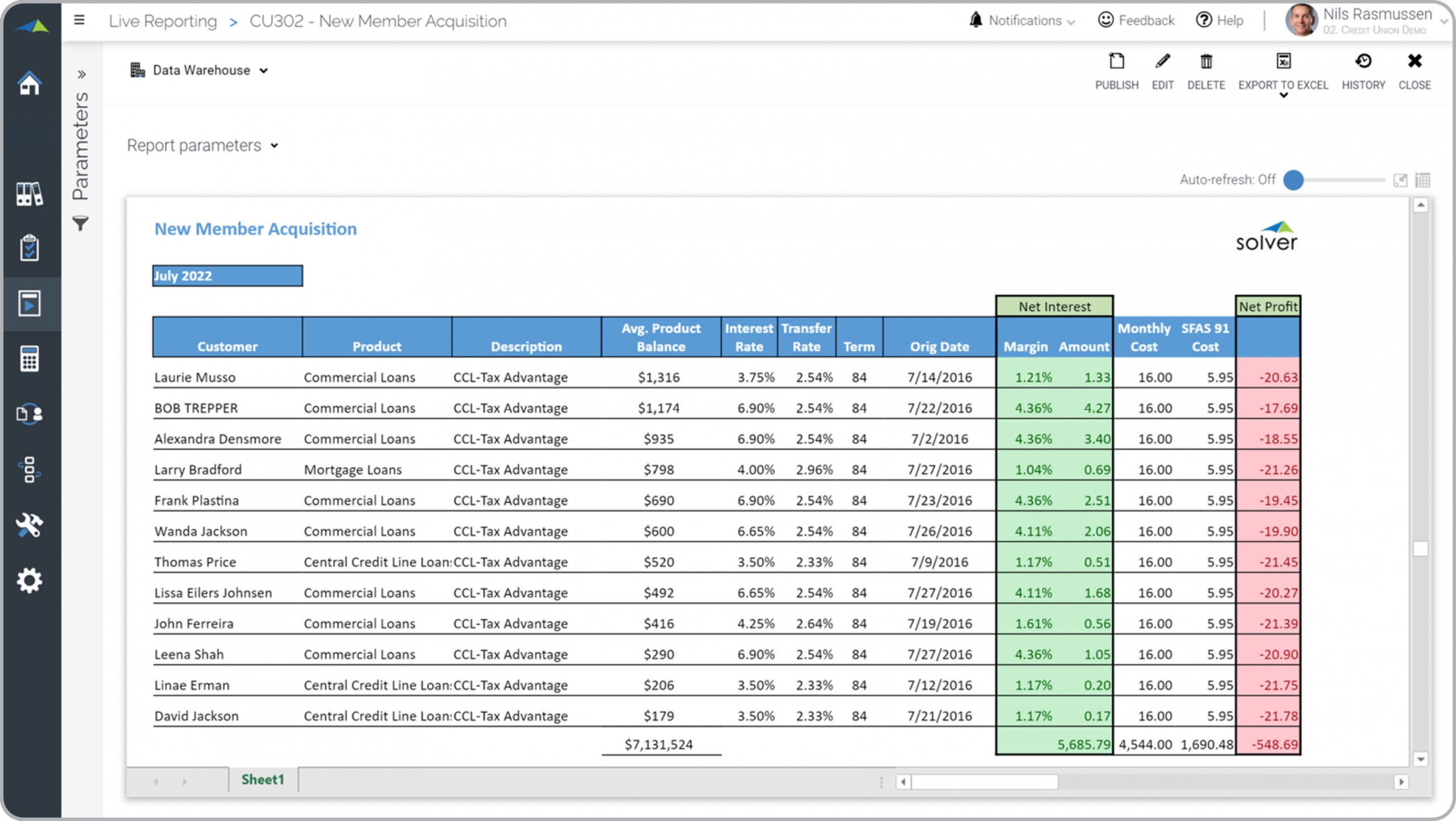New Member Acquisition Report for Credit Unions
What is
a
New Member Acquisition Report
? New Member Acquisition Reports are considered growth and profitability analysis tools and are used by credit union sales managers and leaders to monitor new member growth and profitability metrics. Some of the main functionality in this type of report is that it shows new member KPIs for any given month and branch. The rows list new members by name and product, and key columns include detail and totals for: Average product balance, Net interest amount, Monthly cost, SFAS cost and Net profit. You find an example of this type of report below.
Purpose of
New Member Acquisition Report
s Credit Unions use New Member Acquisition Report to easily analyze the quantity of new members a branch has acquired and the level of profitability associated with each member and in total. When used as part of good business practices in Production- and Account Management departments, a company can improve its revenue growth strategies, and it can reduce the chances that unprofitable tactics are not quickly addressed.
Example of a
New Member Acquisition Repor
t Here is an example of a New Member Acquisition Report with a detailed listing of new members for a specific period as well as the related KPIs. [caption id="" align="alignnone" width="2560"]
 Example of a New Member Acquisition Report for Credit Unions[/caption] You can find hundreds of additional examples
here
Who Uses This Type of
Report
? The typical users of this type of report are: Account executives, production managers, branch managers, analysts.
Other Reports Often Used in Conjunction with
New Member Acquisition Report
s Progressive Production- and Account Management departments sometimes use several different New Member Acquisition Reports, along with financial statements, annual budgets, sales forecasts, KPI dashboards, Member dashboards and other management and control tools.
Where Does the Data for Analysis Originate From? The Actual (historical transactions) data typically comes from member systems and enterprise resource planning (ERP) systems like: Microsoft Dynamics 365 (D365) Finance, Microsoft Dynamics 365 Business Central (D365 BC), Microsoft Dynamics AX, Microsoft Dynamics NAV, Microsoft Dynamics GP, Microsoft Dynamics SL, Sage Intacct, Sage 100, Sage 300, Sage 500, Sage X3, SAP Business One, SAP ByDesign, Acumatica, Netsuite and others. In analyses where budgets or forecasts are used, the planning data most often originates from in-house Excel spreadsheet models or from professional corporate performance management (CPM/EPM) solutions.
What Tools are Typically used for Reporting, Planning and Dashboards? Examples of business software used with the data and ERPs mentioned above are:
Example of a New Member Acquisition Report for Credit Unions[/caption] You can find hundreds of additional examples
here
Who Uses This Type of
Report
? The typical users of this type of report are: Account executives, production managers, branch managers, analysts.
Other Reports Often Used in Conjunction with
New Member Acquisition Report
s Progressive Production- and Account Management departments sometimes use several different New Member Acquisition Reports, along with financial statements, annual budgets, sales forecasts, KPI dashboards, Member dashboards and other management and control tools.
Where Does the Data for Analysis Originate From? The Actual (historical transactions) data typically comes from member systems and enterprise resource planning (ERP) systems like: Microsoft Dynamics 365 (D365) Finance, Microsoft Dynamics 365 Business Central (D365 BC), Microsoft Dynamics AX, Microsoft Dynamics NAV, Microsoft Dynamics GP, Microsoft Dynamics SL, Sage Intacct, Sage 100, Sage 300, Sage 500, Sage X3, SAP Business One, SAP ByDesign, Acumatica, Netsuite and others. In analyses where budgets or forecasts are used, the planning data most often originates from in-house Excel spreadsheet models or from professional corporate performance management (CPM/EPM) solutions.
What Tools are Typically used for Reporting, Planning and Dashboards? Examples of business software used with the data and ERPs mentioned above are:
- Native ERP report writers and query tools
- Spreadsheets (for example Microsoft Excel)
- Corporate Performance Management (CPM) tools (for example Solver)
- Dashboards (for example Microsoft Power BI and Tableau)
Corporate Performance Management (CPM) Cloud Solutions and More Examples
September 3, 2021
TAGS:
Reporting,
Solver,
report writer,
Microsoft,
member,
template,
practice,
Acumatica,
Netsuite,
Finance,
credit union,
planning,
GP,
fintech,
Business Central,
excel,
ax,
forecast,
Budget,
Dynamics 365,
budgeting,
bank,
Cloud,
Software,
Tableau,
SAP,
example,
best,
Sage,
BC,
D365,
NAV,
Intacct,
financial institution,
CPM,
report,
branch,
SL,
Management,
dynamics,
Power BI,
member acquisition,
new member report,
new member,
profitability by member

